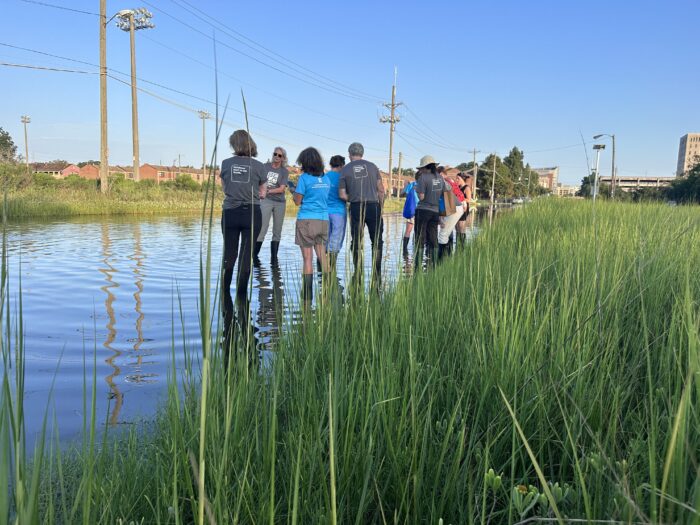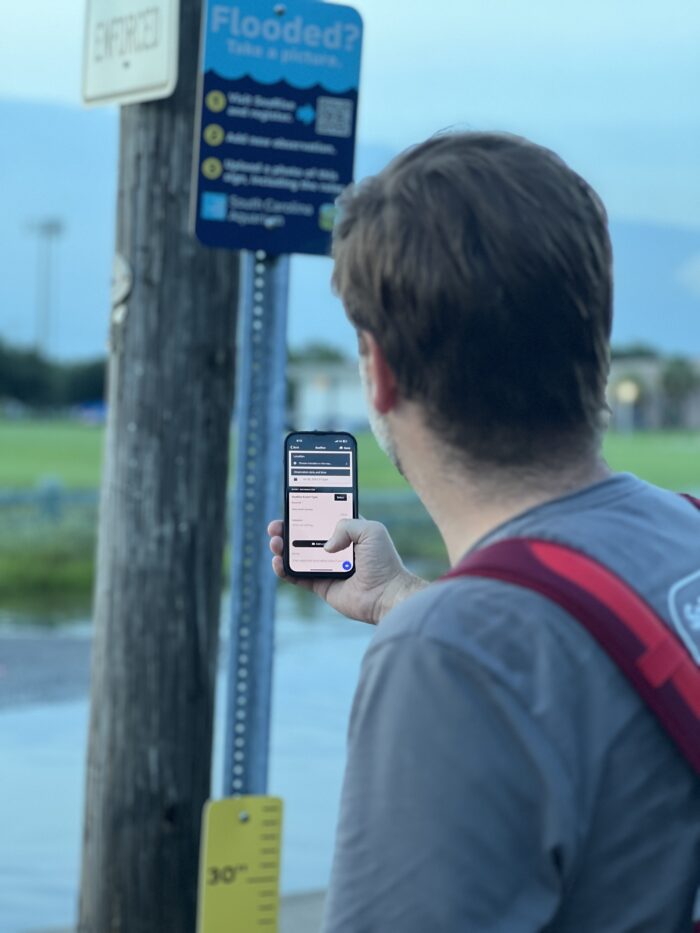Tracking Charleston’s high tides with help from South Carolina Aquarium
When staff from SELC and the South Carolina Aquarium met to kick off their new partnership two weeks ago, they quickly found themselves in deep water — quite literally — in downtown Charleston.
The team was in pursuit of photographing tidal flooding on Hagood Avenue and recording their findings.
As the group waded through seven inches of water, questions surfaced, such as: If this flooding is occurring a few days prior to a predicted “king tide,” how debilitating will these rising waters be during some of the king tide events happening later this year or in future years?

“As South Carolinians experience rising seas and worsening weather events, community partners are the first line of defense. They can ground truth trends and prioritize where intervention is needed most,” said Alys Campaigne, SELC’s Climate Initiative Leader. “We are dedicated to finding solutions to solve the climate emergency that are rooted in science and respond to local needs. That’s why SELC is so proud to partner with the South Carolina Aquarium on their critical, science-focused resilience work.”
Sea level is rising faster in our region than national and global averages. On the east coast of the United States, the average tidal range between high and low tide is about 5.5 feet.
When the moon is in its closest position to earth, a strong gravitational pull can result in tides reaching 6.5 feet or more, unofficially known as king tides. These levels rival storm surges caused by hurricanes but can occur with or without extreme weather events. King tides can result in disrupted commutes, flooded streets, dangerous runoff in our roads and waterways, and significant habitat degradation.
In the Lowcountry, 20 king tides were predicted in 2023, yet that evening’s high tide wasn’t initially on the list. Predictions estimated the tide would reach 6.3 feet (a level higher than a routine tide), yet preliminary data from the National Oceanic and Atmospheric Administration measured the tide at 6.56 feet.
At SELC, we are dedicated to finding solutions to solve the climate emergency that respond to local needs.
Alys Campaigne, SELC’s Climate Initiative Leader
In addition to king tides, NOAA and the National Weather Service classify “minor” tidal flooding when water levels reach 1.8 feet above the average high tide height. In Charleston, that type of tidal flooding starts at seven feet or more. That’s the point when roads close and stormwater drains back up. Based on data from the past five years, Charleston is seeing an average of 63 tidal flooding events per year.
“Local residents are coping with the impacts of sea level rise more and more frequently and it’s easy to become overwhelmed by the problem,” said South Carolina Aquarium Director of Conservation Dr. Sara McDonald.
In 2017, the Aquarium founded the Resilience Initiative for Community Engagement (RICE) to focus on fieldwork opportunities that help alleviate impacts of climate change. This initiative connects at-risk communities across the state with the tools to understand and track trends in flooding and habitat loss, ultimately leading to actionable change.

Such tools include the SeaRise Project, located in the South Carolina Aquarium Citizen Science app.
“The SeaRise Project empowers residents to be part of the solution by collecting data that can directly support local flood modeling and resilience planning,” said McDonald.
As the Aquarium’s efforts in resilience grow, so does their support from community members and partners. As the lead partner of RICE, SELC’s new partnership will support ongoing resilience work, from habitat restoration projects and citizen science data collection to training workshops and community outreach events, to help tackle some of the toughest environmental challenges facing South Carolina.
“At SELC, we are dedicated to finding solutions to solve the climate emergency that respond to local needs,” said Campaigne. “That’s why we are so proud to partner with the South Carolina Aquarium on their critical, science-focused resilience work.”
Together, the Aquarium and SELC are committed to galvanizing community involvement in their resilience work and are asking for help in collecting data during upcoming predicted king tide events from August 29–September 1.
Citizen scientists are encouraged to measure and photograph flooding that occurs in their own area or visit one of the five Charleston locations marked by official SeaRise signs with rulers to measure water levels. All data can be submitted to the SeaRise Project located in the South Carolina Aquarium Citizen Science app, available in the App Store or on Google Play.
For more information, visit scaquarium.org/resilience.
